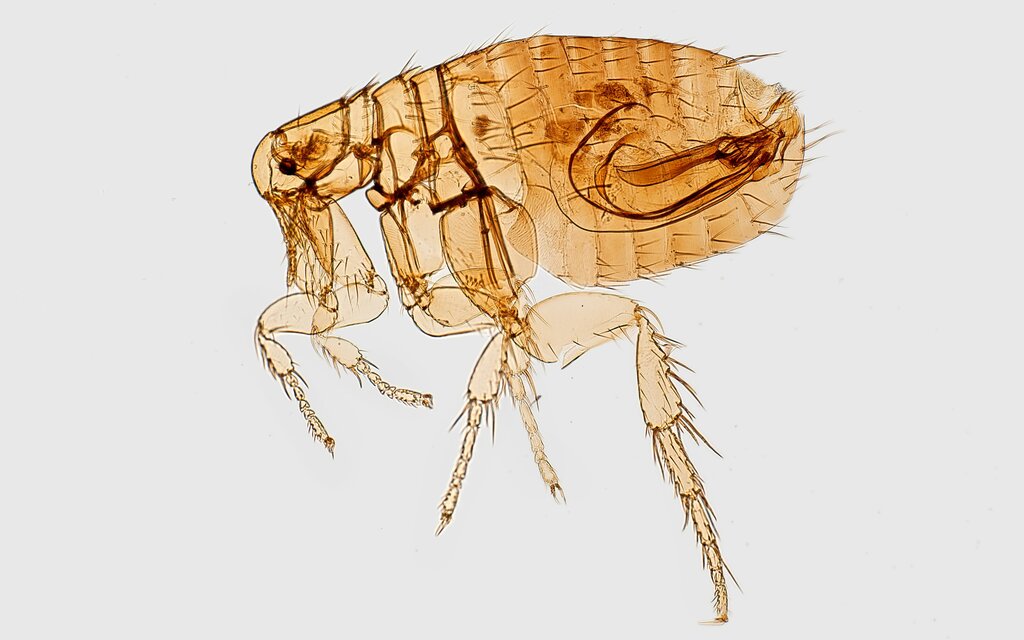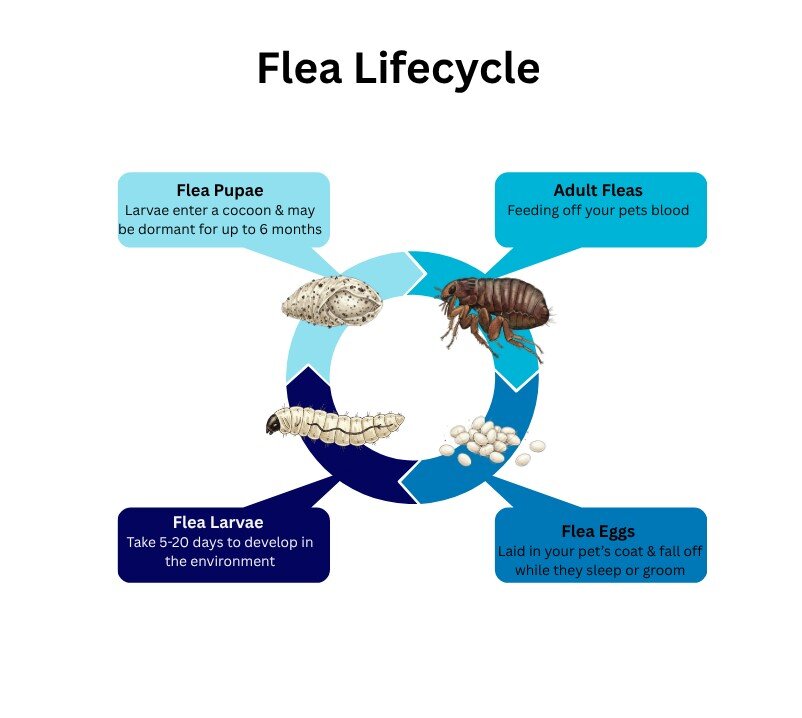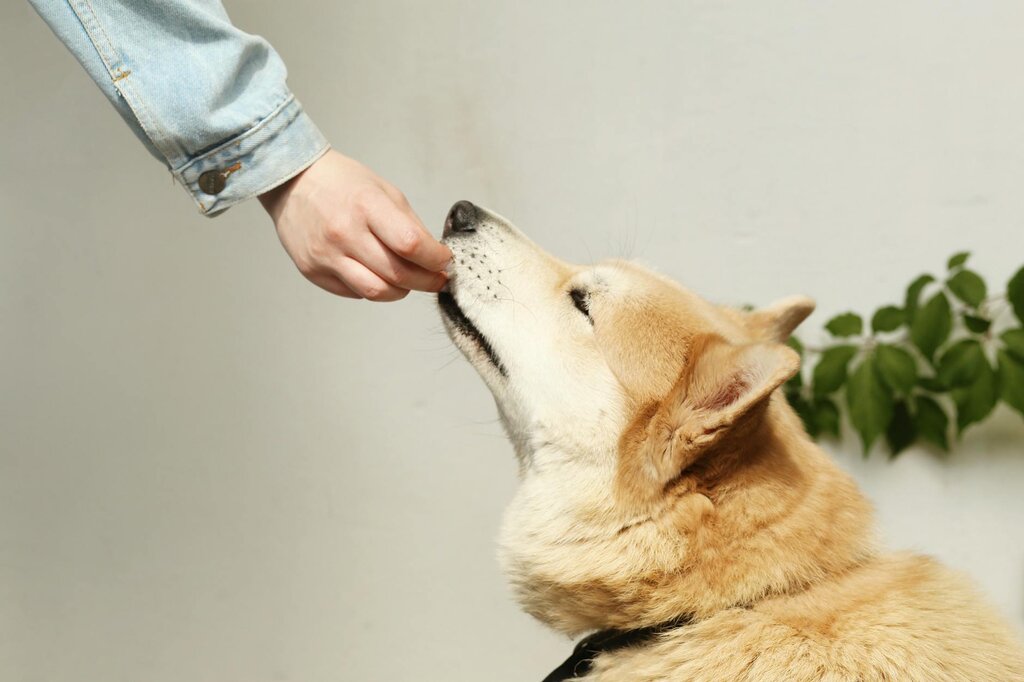Last Updated: 27/10/2025
Fleas on dogs: A vet's guide to signs, treatment and prevention
Is your dog scratching? Fleas are a year-round pest for Aussie pets, causing itchy skin and even flea allergy dermatitis. Our vet explains how to spot an infestation, how to treat your dog, and the crucial steps for getting rid of flea eggs in your home.
Author: Dr Michelle Wong BVSc
Reading Time: 8 minutes - short read
Fleas are more than just a nuisance for dogs - they can cause serious discomfort and health issues. Understanding these pesky parasites is crucial for every dog owner, especially considering that fleas can be active all year round in warmer climates like Australia.
In this comprehensive guide, we'll delve into everything you need to know about fleas on dogs, from their life cycle and how they spread to the signs of infestation and the best methods for prevention and treatment. Whether you're a new pet owner or a seasoned dog lover, this article will equip you with the knowledge to protect your furry friend from these persistent pests.
What are fleas?

Fleas are tiny parasitic insects that feed on the blood of pets and cause itchy skin irritation. Fleas do not have wings to fly but they are able to leap up onto the skin and coat of dogs and cats. These parasites prefer hosts with fur, aka your pets, as the thick hair provides protection and allows them to successfully reproduce.
How do you know if your dog has fleas?

Have you noticed your dog scratching frequently? Perhaps their coat appears speckled with dirt or is looking a little patchy? These are common signs of a flea problem.
Key symptoms to watch for include:
- Constant itching and scratching: This is often the first and most obvious sign.
- "Flea dirt": These are small black specks in your dog's fur, which are actually flea faeces.
- Presence of live fleas: You may spot these small, fast-moving brown insects, especially around the lower back, tail base, and groin.
- Hair loss: All that scratching can lead to thin or patchy areas of fur.
- Skin irritation: The skin may appear red and inflamed due to flea bites.
- Flea Allergic Dermatitis (FAD): Some dogs have an allergic reaction to flea saliva, which causes intense skin irritation.
If not treated, the constant scratching can cause the skin to bleed or develop a secondary infection, making the problem progressively worse.
For more information, read through our article on How to Tell if a Dog has Fleas.
How do I know if my dog has fleas or allergies?
Constant skin irritation and scratching, along with spotting fleas in your pet's coat, is a classic telltale sign of a flea problem.
Always make sure that your dog is up to date on reliable flea prevention, check their coats regularly for active fleas or flea dirt, and be sure to visit your vet if you notice itching, redness of the skin and hair loss.
With a flea infestation, you may easily find adult fleas moving around your pet's fur as you part the coat to take a look. Or you may find speckles of 'dirt' which are actually flea droppings. Flea combs can be useful when examining your pet for fleas. These combs can help brush out small fleas, flea dirt as well as other debris from their coats.
If your dog is on regular flea protection and their coat appears clean, it is less likely that fleas are going to be causing their skin issues. There are a wide range of other reasons for dogs to scratch. Allergies can be common in dogs, and there are many forms of allergies such as contact allergy, food sensitivity or environmental allergy (atopy).
Have you treated your dog for fleas but they're still scratching? Read more about When Your Dog's Itchy Skin Isn't About Fleas.
How do fleas spread?

Fleas can spread by jumping from host to host, from pet to pet, and yes, humans can even get fleas from dogs, though because we are not a flea's preferred host, they don't tend to stick around on us.
Fleas could be anywhere, all year round, although they do tend to thrive in warmer climates so there is often increased flea activity and larger populations with the right temperatures.
This does mean that even if your dog does not come into contact with another animal with fleas they can still get fleas even just being at home and in the backyard. Other potentially risky scenarios involve going to the groomers, vet clinics, moving into a new house that previously had pets or using second-hand furniture.
Read more about the many ways dogs can get fleas (and in every season including winter).
Flea lifecycle

Understanding the flea life cycle is essential for effective control. It has four distinct stages: egg, larva, pupa, and adult.
A common misconception is that all fleas live on your pet. In reality, only the adult fleas do. The other three stages - egg, larva, and pupa - are found in your home environment.
The cycle works like this:
- Adults and Eggs: An adult female flea living on your pet can lay up to 50 eggs per day. These eggs fall from your pet’s coat into the environment - contaminating your carpets, furniture, pet bedding, and floorboards.
- Larvae: The eggs hatch into tiny, maggot-like larvae. These larvae hate light and will burrow deep into carpets, under furniture, and into cracks in the floor to hide.
- Pupae: The larva spins a sticky, protective cocoon (the pupal stage) around itself. This stage is extremely resilient and can lie dormant for months, waiting for the right conditions.
- Emerging Adults: The pupa can detect vibrations, heat, and carbon dioxide from a potential host (your pet or you) walking by. This triggers the adult flea to hatch, jump onto the host, and begin feeding almost immediately, starting the cycle all over again.
This combination of rapid egg-laying and a tough, long-lasting pupal stage is why a flea population can explode quickly and be so difficult to remove from the home.
Treating fleas on dogs

Find out more about the different spot-ons and when you can bathe your dog after applying flea controls.
Shampoos can be helpful in removing fleas and flea dirt physically from the coat. Frontline spray may be used for young animals (from 2 days old).
Besides the use of flea treatments, it is important to treat the environment as well. Thorough cleaning of bedding, blankets and vacuuming could help to remove lurking fleas.
For more information, follow our vet guide on how to get rid of fleas in dogs.
Use an effective and reliable long-lasting flea treatment to quickly get on top of the flea infestation and maintain ongoing control by giving this treatment regularly. Oral flea tablets such as Nexgard, Simparica or Bravecto are excellent products to treat fleas.
Capstar tablets work especially quickly to kill adult fleas (within half an hour) but are only effective for about 24 hours. These can be used for swift reduction of fleas on your dog before starting a long-lasting treatment.
Spot-on flea treatments like Advantage, Advantix or Advocate may be used. Always check the label for the proper application method and bathing recommendations to ensure maximum efficacy as this may have an impact.
Vet Recommended Flea Products
Protecting your dog from fleas
The best way to prevent a flea infestation is to provide continuous parasite prevention. Treat all pets in your household for effective control. Maintaining good hygiene practices and regular cleaning can help reduce numbers of fleas in the environment.
Learn about the best flea and tick treatments for pets in Australia and find one that is suitable for you.
Consulting your vet

Our Pet Circle Vet Squad is available to provide general advice for your pet on which products to use and how to break the flea life cycle, as well as troubleshooting issues such as why your dog is still scratching after administering flea treatment.
If your dog has signs of dermatitis, redness, hair loss, and severe itching, they will need to see their veterinarian for a physical examination and treatment. Flea allergy dermatitis is a common complication and medications may be needed to treat the inflammation and alleviate the itch to prevent further damage.
FAQs
Fleas are common, year-round pests in Australia that can cause significant health issues for your dog, including intense itching and flea allergy dermatitis. The flea life cycle is incredibly resilient, with eggs and pupae hiding in carpets and bedding for months, making infestations difficult to clear.
The most effective strategy is prevention. Using a reliable flea treatment regularly for all pets in the household is the best way to break the life cycle and keep your dog protected. If your dog shows signs of severe skin irritation or hair loss, always consult your vet for treatment.
Articles recommended for you
Our vet authored guide to the benefits of feeding your dog fresh food plus tips and advice for introducing it into their regular menu.
See our guide to protecting your pet from parasites from our vet team.
Thinking of getting a fish? Check out our guide for setting up a tank and home care tips!
Looking to understand horse feeds better? This comprehensive guide covers feeding recommendations for horses of all ages and disciplines.
Does your pet suffer from anxiety? Check out our Vet-guide for treatment options to help your pet.
History
Our experts continually monitor the health and wellness space and we update our articles when new information becomes available.
Tue 21 Oct 2025
Edited by Dr Gillian Hill BVSc (Hons)Dr Michelle Wong BVSc
Veterinarian
Dr Michelle graduated from the University of Queensland in 2011 with a Bachelor of Veterinary Science and has worked in small animal practices around South East Queensland. As an owner of three cats, it is not surprising that Dr Michelle holds special interests in feline behaviour and medicine, as well as dermatology and preventative health care. Her favourite part of being a vet is witnessing the special bond between pets and their owners and helping pets live a happy and healthy life.

